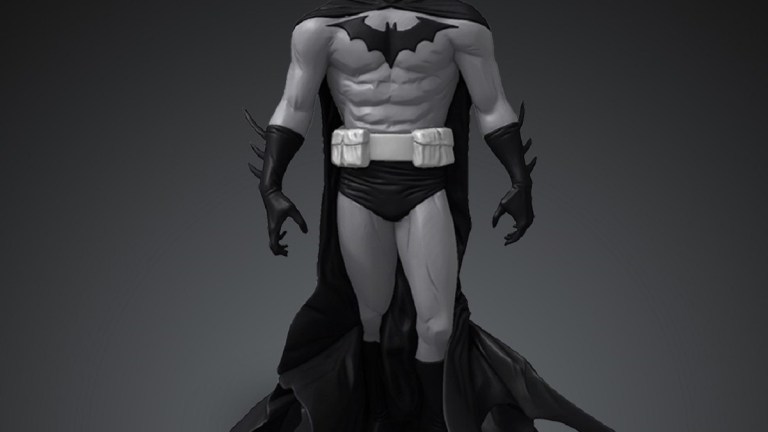What Are NFTs and Why Are Comics Companies Selling Them?
NFTs have taken the art world by storm, and now DC Comics and other publishers are trying to get in on the game.

With an announcement from collectible maker VeVe, the world was introduced to the first officially licensed DC NFTs. “What is VeVe?” you might ask. Or possibly “What is an NFT?”
Excellent questions, friends! We will do our absolute best to explain them in clear, concise terms to you right now.
Here are simple answers to complicated questions: NFTs are ecologically devastating vaporware created to part very dumb, very wealthy collectors from their money, made by stoned libertarian math nerds trying to prove a point they think is profound but is actually just very banal. Veve is no different than any other secondary huckster that springs up around a particularly successful snake oil economy.
As for why DC is getting in bed with them, it’s hard to know if the company is trying to just be cutting edge or if it’s because AT&T took on a shitload of debt buying Warner, and like anybody with creditors breathing down their neck, they need to make several quick bucks or else.
THE NEXT EVOLUTION IN COMICS HUCKSTERISM
Two full decades after Metallica teamed up with record labels to make sure we didn’t own anything we purchased digitally, a group of rejected Captain Planet villains came up with a workaround: NFTs.
NFTs use blockchain, a distributed AI accountant that requires ENORMOUS amounts of processing power to work properly, to assign certificates of ownership and record transactions. Accepting the pitch behind blockchain technology requires one to step back to an absurdly abstract level, then a zoom back into the extremely micro.
Every transaction between two people is built around trust: I trust that you are giving me the thing I’m paying for, while we both trust that the currency I’m handing you has a (relatively) absolute value which will allow it to be traded for other things. Blockchain purports to eliminate that trust: it uses a distributed ledger that anyone can see and confirm to record our transaction; it uses an algorithm to make sure every copy of the ledger is the same; and it assigns tokens to each transaction that can be given a value.
NFTs add in an absurd additional abstraction: ownership of digital media. I have always had the ability to, for example, produce an animated reaction gif from a television show and sell that animated reaction gif to you for a fixed sum of money. You would be an idiot for purchasing that reaction gif for several reasons: anyone else could make the exact same gif and you could find it in iMessage’s search engine, for one. But nothing in the past has ever prevented this transaction from occurring.
The “innovation” around NFTs is that it uses blockchain technology to “prove” “ownership” and “authenticity,” a sentence that is so heavily caveated that to express it correctly in writing makes the writer look like a conspiracy theorist. The NFT assigns a ledger value to the piece of digital artwork, and then that ledger value is what is sold between parties. It is a non-fungible token – unlike Bitcoin or other cryptocurrency, the idea is these art pieces’ tokens’ inherent value doesn’t change (hence the non-fungible), while cryptocurrency is a token whose value is relative to other less imaginary currency.
This has led to some frankly embarrassing sales online. Jack Dorsey, the vacuous and bizarre founder of Twitter, is auctioning off his first tweet, something that already happened, that you can find with one simple Google search, for millions of dollars. Beeple, an artist the internet assures me is real, auctioned off a digital JPEG collage of all their previous works for $69 million. Jose Delgo, a comics artist from the ‘70s that very few people remembered until this happened, has made almost $2 million selling NFTs of his own artwork, spurring DC to email freelancers to remind them that they should not be using DC characters to try and skate atop this obvious bubble. Not because of the catastrophic environmental impacts caused by the blockchain algorithm, mind you. No, it was because AT&T needed to get some of that sweet, sweet tulip money.
THIS MACHINE KILLS FASCISTS MOSTLY POOR PEOPLE
Joanie Lemercier, a French artist and climate activist, has sold six NFT pieces so far. The act of accounting for those sales – assigning a token, then transferring ownership of that token from Lemercier to the purchaser – was 8.7 megawatt hours of energy. That’s roughly equivalent to the entire energy consumption of his studio for two entire years.
The algorithm used for NFTs, like the one used for Bitcoin, other cryptocurrency, and all blockchain transactions, requires computers perform a certain volume of complex activity to access the ledger. That’s how it prevents fraudulent transactions – by making the barrier to writable access so high that it’s functionally impossible.
Of course, as demand for these transactions increases, so too does the computing power needed to record them. Hence the massive power consumption from Lemercier’s sale. Bitcoin transactions, especially since Elon Musk invested heavily in them to drive up their price (presumably the “pump” part of “pump and dump”), now use more energy annually than the entire country of Argentina.
Here’s the catch: in a perfectly green, zero emission energy environment, this wouldn’t be a huge problem. Unfortunately, as anyone who has gone outside in the past 18 months has noticed, we’re not quite there yet. And while adding another Argentina to global power load isn’t the same as adding another China, it is still a significant drain on existing grids, and if it’s not timed and sited right, it’s using very dirty power (it’s fairly complicated, but the short version is electricity generation generally gets dirtier as demand increases).
So when Grimes auctions off a certificate of creation for her digital artwork, she’s triggering a set of computer actions that put a massive stress on the power grid that churns out oodles of negative environmental consequences, which according to study after study fall disproportionately on poor people and people of color.
Or! Instead of auctioning off something that clearly doesn’t exist, maybe she’s just using fracked natural gas as laundry detergent for mafia cash.
DIGITAL MONEY LAUNDROMAT
Let’s say I was a certain very sadistic, very fictional, black mask wearing crime lord of an American city and I have $1 million in cash lying around that I made from my operation’s drug business. If I suddenly bought a house with that million dollars, the authorities would notice that large transaction (probably through transaction reporting from the bank handling the sale, or the property exchange paperwork that runs through City Hall) and start sniffing around to find out where that money came from.
The same goes if I were to purchase IRL fine art through an auction house. The auction house would ask questions about where that money came from, and if it didn’t like what it found, it would report it to the authorities. Same for buying cars, or businesses, or lots of other real life transactions.
Now replace bank, city hall, and auction house with “a bunch of computers playing tic tac toe against each other on a 1025 square board” and try and guess where the reporting comes in. We don’t have to wait for an answer, that reporting doesn’t exist.
NFT transactions are the perfect confluence of the shadiness of art dealing with the shadiness of off-book dark web money-moving. They’re not all money laundering, but they are easy enough to use as money laundering that the authorities are getting concerned.
PRECARITY, PANDEMICS, AND COMICS ART
So why are comics people doing this? To start with, we mean actual people, and not people in the legal sense of the word (corporations).
It’s not hard to see the eye popping amounts of money changing hands and understand why at least some of them are getting involved. But it’s equally easy to look at the economics of the pandemic era of comics creation and at least sympathize with the pull. Comic page rates have been largely stagnant since the 1980s – penciler page rates in recent years are actually lower than the modest demands made by creators during the abortive effort to unionize in the 1970s.
With that money being so limited, most artists relied on the sale of original art, sketches, and sales at conventions to help make ends meet. So the last year has been exceptionally tough on them. Add to that the trend towards digital art, where there’s no actual physical page produced for the comic, and it’s not hard to imagine a hard up artist, one year into not seeing another living soul except for when the grocery clerk brings a bag of food out to their car, seeing someone coming along waving a conservative five figures at them and not explaining the extremely convoluted yet catastrophic environmental impact of the proces, saying yes to the quick cash.
To their credit, many comics creators are repulsed by the idea. Several have expressed serious concerns with NFTs on Twitter, with Doomsday Clock artist Gary Frank expressing “bewilderment” at the idea of his art being used to sell one of these things, and Marsha Cooke, widow of New Frontier great Darwyn Cooke and manager of his estate, going so far as to ask DC to stop using his art in them.
Hopefully the companies involved (or thinking of getting involved) with NFTs listen to their creatives. Nothing more honors the spirit of Batman than using his image to help give a pallet of Bratva money a quick scrub.
